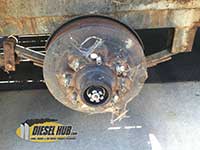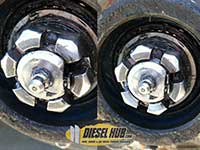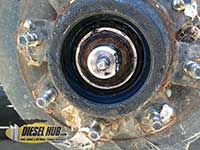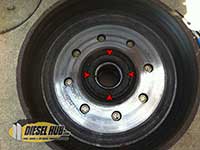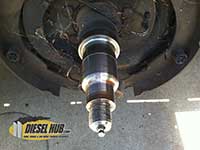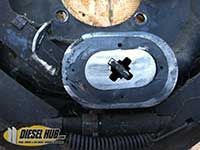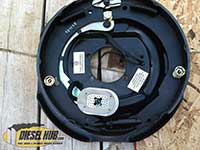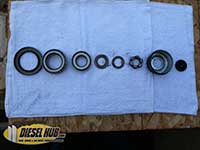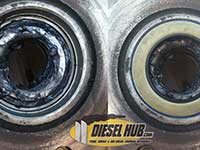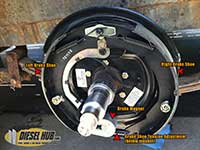In a typical electric trailer brake system, energizing a magnet within the brake assembly causes the brake shoes to apply a force against the brake drum proportional to the voltage applied to the magnetic actuator. The magnet is fixed to a lever arm that, when activated, moves a pair of brake shoes (the equivalent of brake pads in a drum brake setup) against a rotating brake drum, creating friction and effective stopping force. When energized, the magnet is attracted to the face of the iron brake drum, and therefore controlling the amount of stopping power is as simple as increasing or decreasing voltage to the magnet. Most brake actuating magnets have an epoxy coating, and overtime they wear from normal use.
Click any thumbnail image to view full-size image
• Begin by breaking loose all the lug nuts while the trailer is on the ground. Next, jack the trailer up high enough to remove the tire(s) and support it with jack stands. Never work under a jack alone, always support the axle or a nearby section of frame-rail with jack stands to protect yourself in the event a jack fails or slips.
• Remove the wheel/tire from the axle to access the brake drum and assembly.
• Remove the dust cap from the axle hub to access the retaining nut. Channel locks, a large screwdriver, and a lot of finesse typically gets the job done without tearing apart the dust cap.
• Remove the cotter pin or nut retainer in order to remove the castle nut from the spindle. This trailer has a retaining clip, which just needs to be bent (as pictured) in order to allow the nut to spin freely.
• Remove the retaining nut from the axle spindle, and then the brake drum from the spindle. The outer wheel bearing should slip right out; discard it, never reuse wheel bearings. If the drum sticks and/or won't budge, gently tap the perimeter with a metal hammer until it frees itself. Brake drums tend to become temperamental with age and use.
• Visually inspect the brake drum for excessive wear and uneven scoring. Replace brake drums that are in poor physical condition. If the drum is not worn excessively and its thickness is within spec, there's no reason why it cannot be reused. If in doubt, have your local auto parts store inspect the drums; they may be able to machine (a process called "turning") them at a lower cost than a new drum altogether.
• Remove the inner wheel bearing and wheel bearing seal (red arrows). The bearing should slide right out once the seal is removed. The bearing seal is pressed into place, and any combination of tools can be used to remove it if you do not have a bearing seal puller (flathead screwdriver, pick, pliers, etc). Don't worry about tearing up the seal, it does not get reused; just get it out.
• Remove the inner wheel bearing - again, the wheel bearing does not get reused.
• With the drum and bearings removed, clean all the old grease from the brake drum and spindle. This is also a good time to clean the zerk fitting by pumping it full of fresh grease and discarding the old. At this time, check your bearing races for wear. If the bearing races are scarred, they will need to be removed and replaced (since they are tightly pressed in, welding a metal rod to the race is often required to pull them).
• The brake assembly can be rebuilt with new shoes, magnet, and hardware, or you may opt to replace the entire backing plate assembly. This assembly was secured by five 3/8" bolts, and the wire for the magnet needed to be cut. The bolts were corroded and after shearing a few, we decided to replace them all with fresh hardware. At this point, you can see that this magnet was badly worn and in desperate need of replacement.
• No prep work was required for our new brake assembly, though we did hit the brake shoes with a liberal shot of brake cleaner and a clean rag for good measure. Bolt the new assembly into place and crimp in the two wires of the new magnet where you cut the old ones. Magnets are not polar sensitive, and therefore the positive and negative poles are interchangeable. For good measure, always heat shrink wire crimps.
• Everything should be cleaned before being reinstalled. Remove old grease with brake cleaner. As you can see here, we always line up items in the order they are removed to ease reassembly. The new wheel bearings need to be packed with grease. This can be done the old fashion way, using the palm of your hands, or with a bearing packer. We used our hands; it's messy but easy to tell when the bearings are properly packed with grease. Always use a high temperature wheel bearing grease.
• Packing wheel bearings is not rocket science - the amount of grease on the outside of the bearing is irrelevant. The goal is to completely pack the inside of the bearing with grease. If you can see un-greased voids between the bearings and bearing race, apply more grease.
• Reinstall the outer wheel bearing, then the new bearing seal by lightly tapping it with a hammer until it is completely and evenly seated.
• Attempt to reinstall the brake drum and proceed as follows:
• If the drum will not slide over the new shoes, tighten the tension adjuster located at the bottom of the brake assembly to bring the shoes in until the drum can slide into place.
• If the drum slides over the shoes, rotate it and feel for friction between the drum and shoe. If there is no friction, loosen the tensioner until the shoes barely grab the drum, and then back it off until they do not. If the shoe is grabbing the brake drum, tighten the tensioner until the shoes do not grab.
The end goal is to have a brake shoe that does not drag on the brake drum when the brakes are deactivated, but also does not exhibit excessive play in the engagement of the brakes. Drum brakes will self adjust in time, but this does not negate the need to properly set the initial tension. This process requires a "feel" that cannot be fully explained and is only obtained with experience. If you're new to working with drum brakes, be patient.
• Reassemble the axle hub in reverse order - install the drum, then the outer wheel bearing, the outer bearing washer, retaining nut (castle nut), cotter pin/retainer, and finally the dust cap. Be sure to set proper tension on the spindle retaining nut - preload the nut until all end play is removed from the wheel assembly, i.e. there is no end play when attempting to pull the drum off of the axle. Once you've determined there is no end play, tighten the nut 1/4 turn and install the retainer/cotter pin.
Note - if a dust cap is damaged or does not seat neatly against the axle hub, replace it; they are inexpensive and a good seal is desirable.
• Grease the axle spindle via the zerk fitting as you would during a routine service (5 - 7 pumps of a grease gun typically suffices).
• Reinstall the wheel and tire, then torque the lug nuts to factory spec.
• Once the brakes have been replaced on all axles, test for proper actuation. Drive cautiously until brakes have had time to properly break in. If a trailer pulls to one side when the brakes are activated, you may need to adjust the brake shoes once more.
